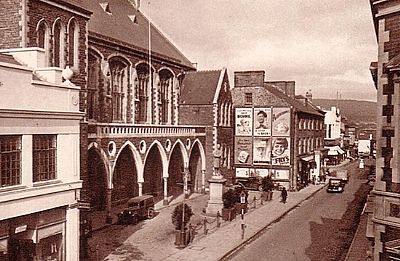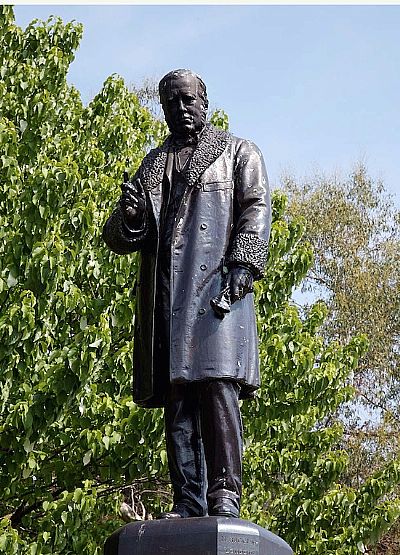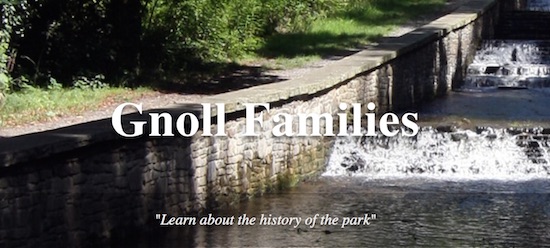Hywel Gwyn and famous Neath Historic Families
Hywel Gwyn
 A statue of Howel Gwyn was unveiled outside the hall, which was named after him.
A statue of Howel Gwyn was unveiled outside the hall, which was named after him.
The positioning of the statue caused controversy at the time as it was thought that it would interfere with traffic. Subsequently in 1967, the statue was moved to its present position in the nearby Victoria Gardens. The statue pointed to Howel Gwyn's birthplace opposite the Gwyn Hall, which was demolished in the 1960s and replaced by a Woolworths.
 Howel Gwyn, benefactor of the Gwyn Hall, was a prominent public figure in Victorian Neath society. During his political career he had served as alderman, town councillor, mayor, Freeman of the Borough, chairman to the board of Guardians, High Sheriff of Glamorgan and MP for Brecon and Falmouth.
Howel Gwyn, benefactor of the Gwyn Hall, was a prominent public figure in Victorian Neath society. During his political career he had served as alderman, town councillor, mayor, Freeman of the Borough, chairman to the board of Guardians, High Sheriff of Glamorgan and MP for Brecon and Falmouth.
A generous benefactor to the town he was revered for his paternalism having made substantial gifts and land for St David’s Church, Alderman Davies School, the building of the Constitutional Club and St Matthew’s Church, Dyffryn where he is buried. At his mansion in Dyffryn he hosted an annual fete for his tenants and provided the Christmas luncheon at the Neath Union Workhouse.
In 1882 Alderman Howel Gwyn, a prominent public figure in Victorian Neath society, offered to assist in the finance of a new public hall and municipal offices for the town of Neath. After a number of years a site for the new hall had not been found and so at a public meeting in 1885 Gwyn announced that he would find suitable land himself donating the site on Orchard Street for the purpose. Funds for the project could not be raised by The Neath Corporation and to ensure the halls completion Gwyn agreed to pay for the building as well, donating a further £200 for the project. The final cost of the hall however was estimated at around £6,000. It was agreed that Gwyn could choose the architect himself and in March 1886 plans were received from London-based architect John Norton who also designed St David’s Church in Neath.
Sir Humphrey Mackworth (Jan 1657–1727) was a British industrialist and politician who in1686 married Mary Evans of Neath and he moved to Wales soon after. Mary was the daughter of Sir Herbert Evans of Gnoll in Neath and she became the sole beneficiary of Sir Herbert's estate after the death of her sisters. The Evans family had, for the last two generations, controlled the leases that allowed virtually sole-control of coal mining rights in Neath. The coal from the area had been used for smelting and Mackworth became interested in working with copper and lead, and may have begun copper smelting 1695 at Melincryddan. In 1696, Mary died, leaving Mackworth as the inheritor of the estate, and by 1698 he had branched into controlling interests in Cardiganshire.
Sir David Martyn Evans-Bevan (4 March 1902 – 9 September 1973) was a wealthy industrialist from south Wales. He was the owner of the Vale of Neath Brewery, and purchased Margam Castle from the Talbot family.
David Evans-Bevan inherited the Vale of Neath Brewery from his father, Evan Evans-Bevan. David married Eira Winifred Glanley, daughter of Sidney Archibald Lloyd Glanley, in 1929.
In 1942 he acquired the Margam estate.
David Evans-Bevan bought two Spitfires to help the war effort, and was known for his help towards the council.
On 9 July 1958 Evans-Bevan was created a baronet, of Cadoxton-juxta-Neath in the County of Glamorgan.
In 1967, Sir David sold the brewery to Whitbread, and it finally closed in 1972.
David Evans-Bevan died in September 1973, aged 71, and was succeeded in the baronetcy by his son Martyn. His widow, Eira, died on 24 December 2001.
Source: Wikipedia


